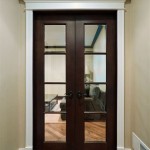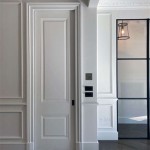What Kind of Paint Do You Use on Interior Doors and Trim?
Selecting the appropriate paint for interior doors and trim is a crucial decision that impacts both the aesthetic appeal and the longevity of the painted surfaces. Interior doors and trim, including baseboards, door frames, window casings, and crown molding, are subjected to frequent contact, potential abrasion, and the occasional impact. Consequently, the paint must possess durability, washability, and the ability to resist chipping and scratching. Various paint types cater to these requirements, each with its own set of advantages and disadvantages. This article will explore the common paint types suitable for interior doors and trim, highlighting their characteristics and optimal applications.
The primary considerations when choosing paint for interior doors and trim revolve around durability, appearance, and ease of application. Durability ensures the paint withstands the wear and tear associated with daily use, resisting scuffs and stains. Appearance refers to the sheen or finish of the paint, which influences the overall look and feel of the space. Ease of application encompasses the paint's flow, leveling properties, and drying time, affecting the efficiency and outcome of the painting process. A thorough evaluation of these factors will guide the selection of the most appropriate paint for the specific needs of the project.
Understanding Paint Sheens for Interior Doors and Trim
Paint sheen, also known as paint finish, refers to the amount of light that reflects off the painted surface. Different sheens offer varying levels of durability, washability, and aesthetic appeal. The most common sheens for interior doors and trim include high-gloss, semi-gloss, satin, eggshell, and matte. Each sheen imparts a distinct character to the room, influencing how light interacts with the painted surfaces and how easily the surfaces can be cleaned.
High-gloss paint offers the highest level of sheen, reflecting the most light. It is exceptionally durable and highly resistant to stains, making it ideal for areas prone to heavy use and frequent cleaning, such as kitchen cabinets, bathroom trim, and, in some cases, doors. However, its high reflectivity also accentuates imperfections on the surface, requiring meticulous surface preparation. High-gloss is often used for creating bold, dramatic effects.
Semi-gloss paint offers a slightly lower level of sheen than high-gloss but still provides excellent durability and washability. It is a popular choice for interior doors, trim, and window casings, as it strikes a balance between aesthetic appeal and practical performance. Semi-gloss is easier to clean than lower sheen options and offers good resistance to moisture, making it suitable for bathrooms and kitchens. Like high-gloss, it can reveal surface imperfections to some degree, necessitating proper preparation.
Satin paint provides a velvety, smooth finish with a subtle sheen. It is a good compromise between durability and aesthetic appeal, offering better washability than matte or eggshell finishes while still concealing minor imperfections. Satin is a versatile option suitable for interior doors, trim, and even walls in moderate-traffic areas. Its subtle sheen adds a touch of elegance without being overly reflective.
Eggshell paint has a low sheen, resembling the texture of an eggshell. It offers a soft, subtle finish that is more forgiving of surface imperfections than higher sheen options. While not as durable or washable as semi-gloss or satin, eggshell is a popular choice for walls in living rooms, bedrooms, and hallways. It can also be used on trim if a very low-sheen look is desired and the area is not subject to heavy wear and tear.
Matte paint has the lowest sheen, providing a flat, non-reflective finish. It is excellent at concealing imperfections on walls and is often used to create a sophisticated, understated look. However, matte paint is the least durable and most difficult to clean of the sheen options. It is generally not recommended for interior doors or trim due to its susceptibility to stains and scuffs. Matte paint is best suited for low-traffic areas where durability is not a primary concern.
Types of Paint Suitable for Interior Doors and Trim
Beyond sheen, the type of paint formulation also plays a vital role in the performance and suitability of the paint for interior doors and trim. The two primary types of paint are latex (water-based) and alkyd (oil-based). Each type possesses distinct characteristics that influence its application, durability, and overall performance.
Latex (Water-Based) Paint: Latex paint is a popular choice for interior painting due to its ease of application, low odor, and quick drying time. It is also environmentally friendly, as it contains lower levels of volatile organic compounds (VOCs). Latex paint offers good adhesion, flexibility, and resistance to cracking and peeling. Modern latex paints have significantly improved in durability and washability, making them suitable for interior doors and trim, especially when using higher sheen levels. Latex paints are easier to clean up, requiring only soap and water. However, latex paint may not provide the same level of hardness and resistance to abrasion as alkyd paint, particularly in high-traffic areas.
Alkyd (Oil-Based) Paint: Alkyd paint, also known as oil-based paint, offers exceptional durability, hardness, and resistance to abrasion and staining. It provides a smooth, enamel-like finish that is highly desirable for interior doors and trim. Alkyd paint levels extremely well, minimizing brush strokes and creating a professional-looking result. It is particularly well-suited for surfaces that require frequent cleaning and are subjected to heavy wear and tear. However, alkyd paint has a strong odor, requires longer drying times, and necessitates the use of solvents for cleanup. It also contains higher levels of VOCs, making it less environmentally friendly than latex paint. Furthermore, alkyd paint can yellow over time, especially in areas with limited natural light.
Hybrid Paints: Hybrid paints attempt to combine the benefits of both latex and alkyd paints. These paints are typically water-based but are formulated with modified acrylic resins that provide improved durability, hardness, and flow properties compared to traditional latex paints. Hybrid paints offer good adhesion, low odor, and easy cleanup, while also delivering a more durable and enamel-like finish. They are a viable option for interior doors and trim, offering a balance between performance and user-friendliness.
Acrylic Paint: Acrylic paint is extremely durable. It will resist wear and tear better than other paints and is an excellent choice if you have pets or children. It can be used on your trim with no concerns that the paint will be ruined or damaged over time. It is water-based so you can clean it up with soap and water, and it typically doesn't require a primer.
Preparing Surfaces and Applying Paint to Interior Doors and Trim
Proper surface preparation is essential for achieving a professional and long-lasting paint finish on interior doors and trim. This process involves cleaning, sanding, and priming the surfaces to ensure proper adhesion and a smooth, even appearance. Neglecting surface preparation can lead to paint failure, such as peeling, chipping, and poor adhesion.
Cleaning: Before painting, the surfaces of the doors and trim must be thoroughly cleaned to remove any dirt, dust, grease, or grime. Use a mild detergent and water solution to wash the surfaces, followed by a clean water rinse. Allow the surfaces to dry completely before proceeding to the next step. For stubborn stains or grease, a stronger degreaser may be necessary.
Sanding: Sanding is crucial for creating a smooth, uniform surface and for promoting paint adhesion. Use fine-grit sandpaper (180-220 grit) to lightly sand the surfaces, paying attention to any imperfections, such as scratches or dents. Sanding also helps to remove any existing gloss from previous paint coats, providing a better surface for the new paint to adhere to. After sanding, remove any sanding dust with a tack cloth.
Priming: Priming is an essential step that helps to seal the surface, block stains, and improve paint adhesion. Choose a primer that is compatible with the type of paint being used. For example, use a latex primer with latex paint and an oil-based primer with alkyd paint. Apply one or two coats of primer, allowing each coat to dry completely before applying the next. Priming is particularly important when painting over bare wood, stained surfaces, or surfaces with existing paint in poor condition. Tinting the primer to a similar color as the topcoat can also improve the color coverage and hide imperfections.
Painting: Once the surfaces are properly prepared, the paint can be applied. Use high-quality brushes, rollers, or sprayers to apply the paint in thin, even coats. Avoid applying thick coats, as this can lead to drips, runs, and uneven drying. Allow each coat of paint to dry completely before applying the next. Two coats of paint are typically recommended for optimal coverage and durability. When painting doors, start with the edges and panels, followed by the stiles and rails. When painting trim, work in long, even strokes, following the grain of the wood. Use painter's tape to protect adjacent surfaces and create clean, crisp lines.
Selecting the appropriate paint for interior doors and trim requires careful consideration of sheen, paint type, and surface preparation. By understanding the characteristics of each option and following proper painting techniques, it is possible to achieve a beautiful, durable, and long-lasting finish that enhances the aesthetic appeal of the space.

Best Paint For Trim And Interior Doors Aboff S

Best Paint For Interior Doors Finish Types Compositions

How To Paint Doors Best Practices S Brands Paintwell

How To Paint Trim And Why Satin Is The Best Finish Our Aesthetic Abode

Dark Gray Doors How To Paint Your Own All For The Memories

Home By Sherwin Williams Semi Gloss Ultra Deep Acrylic Interior Exterior Door And Trim Paint 1 Gallon In The Department At Com

How To Paint Trim And Doors Painting 101

Dark Gray Doors How To Paint Your Own All For The Memories

How To Paint White Interior Doors Black Thrifty Decor Diy And Organizing

A Design Expert Explains Why You Should Paint Your Door And Trim The Same Color
Related Posts








